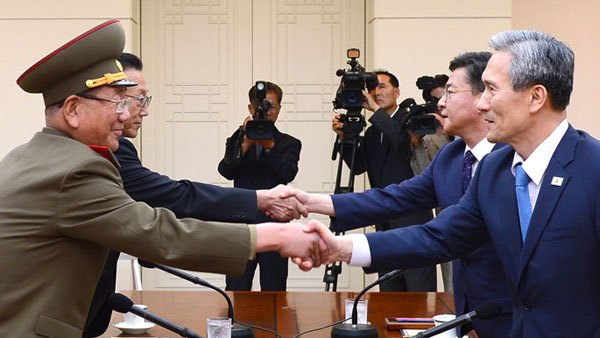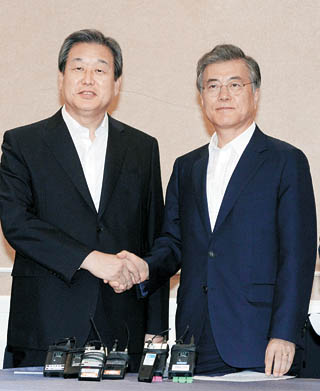Marathon talks arranged while conflict averted

South and North Korea hold high-level talks at the truce village of Panmunjom at 6 p.m. Saturday in an apparent effort to prevent ongoing tensions from escalating into a full-fledged military conflict. From left: Hwang Pyong-so, director of the General Political Bureau of the North Korean Army; Kim Yang-gon, secretary of the Central Committee of the Workers’ Party of North Korea; South Korean Unification Minister Hong Yong-pyo; and Kim Kwan-jin, director of South Korea’s National Security Office. [NEWSIS]
The resumption of the high-level discussions came 11 hours after the first session was adjourned at 4:15 a.m. on Sunday.
South Korea’s director of National Security Kim Kwan-jin and Minister of Unification Hong Yong-pyo returned to the table at the border town for discussions with their North Korean counterparts Hwang Pyong-so, the director of the General Political Bureau of the North Korean Army and Kim Yang-gon, the secretary of the Central Committee of the Workers’ Party, who oversees inter-Korean relations for Pyongyang.
Talks began at 3:30 p.m. Sunday and were ongoing as of press time. The first round lasted 10 hours.

Kim Moo-sung, left, chairman of the ruling Saenuri Party, and Moon Jae-in, right, chairman of the main opposition New Politics Alliance for Democracy, issue an agreement Saturday at the National Assembly in Yeouido, Seoul, to take bipartisan action in response to the military provocations by North Korea. [NEWSIS]
Blue House spokesman Min Kyung-wook told reporters early Sunday after the first meeting that discussions between the two sides had been wide. He said the talks had sought to resolve the current standoff and seek ways to improve inter-Korean relations but did not provide details.
The meeting raised hopes that a direct confrontation at one of the most heavily armed zones in the world could be avoided. Talks were pursued after tensions spiked to levels not seen in years, as the two Koreas braced for a military clash Thursday, when both sides exchanged artillery fire. North Korea first proposed contact Friday.
The fact that North Korean leader Kim Jong-un sent Vice Marshal Hwang, considered the regime’s second most powerful in command, was seen as significant and boosted the expectation that Pyongyang was also seeking to end the military impasse.
As the first round of talks began Saturday evening, South Korea’s presidential office stayed on alert. Presidential chief of staff Lee Byung-kee and other presidential aides stayed awake through the night as the first meeting stretched into the early hours Sunday. President Park Geun-hye was also reported to have been briefed throughout the night.
A senior ruling Saenuri Party lawmaker told the JoongAng Ilbo, an affiliate of the Korea JoongAng Daily, that it was understood Kim Jong-un had also been briefed on the matters addressed during the intermission.
The official statement announced by the presidential office at 4:53 a.m. Sunday raised speculation that there was a considerable gap in both sides’ stance on inter-Korean issues and did not specify progress made during the meeting.
The discussions marked the second time Kim Kwan-jin, the national security adviser, has met with Hwang and Kim Yang-gon, his North Korean counterparts.
He previously spoke with them on Oct. 4, when a high-ranking North Korean delegation visited South Korea to attend the closing ceremony of the Incheon Asian Games. Among them was Choe Ryong-hae, another top aide to Kim Jong-un.
While the men visited Incheon with the reported purpose of attending the ceremony, their presence was widely seen as an overture by North Korea to improve inter-Korean relations, though their trip failed to yield any tangible outcome.
It is anticipated that Pyongyang will refrain from further military provocations for the time being, with South Korea and the United States currently conducting their annual joint military exercises. Any military action would guarantee swift retaliation from Washington, which has nearly 30,000 U.S. soldiers stationed in the South.
Pyongyang’s fear of America’s military might can be evidenced in its persistent rhetorical demands that the joint drills be halted and its reference to the exercises as a “preparation for full-scale invasion.”
Seoul and Washington have traditionally brushed Pyongyang’s saber-rattling, citing the defensive nature of the drill.
While no details about the second round of talks were available by press time Sunday, expectations that the standoff between both sides could come neatly to an end came Saturday when Pyongyang referred to South Korea as the Republic of Korea, its official name, in its report on the discussions.
The reference by the state-run Korean Central Television is something of a rarity, as the regime’s mouthpiece usually addresses South Korea as an “American puppet.”
But while the second meeting at Panmunjom continued, South Korea’s military remained on high alert, and intelligence obtained over the weekend showed that 70 percent of North Korean submarines had been mobilized for operation, raising red flags over potential strikes from underwater.
According to one military source, of the 70 submarines North Korea operates in total, 50 have gone off the radar, meaning they have been dispatched underwater. The official added that the number of submarines suspected of being in operation Sunday was 10 times higher than usual.
“The military keeps close watch on the operation of [North Korea’s submarines] because it could be a barometer of North Korean provocation,” said the official, speaking on the condition of anonymity.
The military found that most of the submarines stationed at Navy units along North Korea’s east and west coasts had been deployed, prompting the South Korean military to bolster maritime surveillance.
The simultaneous disappearance of the 50 submarines was interpreted as a grave security threat to the South Korean military, as it is practically impossible to determine the origin of an attack when it is prompted by a submarine.
The military also discovered that the North Korean Army doubled its artillery power along the DMZ over the weekend in what was seen as part of its typically two-faced strategy, stoking tension to pressure Seoul as it participates in high-level talks.
An expert on the North Korean military said the tactic by the North Korean Navy could be a strategic calculation to apply further pressure on the talks at Panmunjom.
“While it could be a strategic choice [by North Korea] to take the upper hand in the ongoing talks, it could also be military preparation to carry out further provocations in case the talks fall apart,” said the expert, who also asked for anonymity.
Reports on the latest moves by North Korea’s military kept tensions high despite the second round of talks at the border.
The military said Sunday that it continued its propaganda broadcasts via loudspeakers along the DMZ, which was resumed earlier this month in retaliation for the land mine blasts on Aug. 4, which maimed two patrol soldiers.
The resumption of broadcasts - a psychological warfare tactic - 11 years after they were halted via a mutual agreement bristled Pyongyang, which fired artillery shells across the border on Thursday into South Korean territory as an apparent warning sign and ordered its frontline troops to prepare for a “quasi-state of war.”
In an apparent show of force, South Korea and the United States flew F-15Ks and F-16s together and ran simulated bombing sorties on Saturday in an apparent warning to the North of the consequences its actions would cause.
In the political circle, the ruling Saenuri Party and the main opposition New Politics Alliance for Democracy made a bipartisan pledge on Saturday, vowing to actively cooperate in the face of North Korean provocation by putting aside political bickering for the time being.
BY KANG JIN-KYU [kang.jinkyu@joongang.co.kr]










with the Korea JoongAng Daily
To write comments, please log in to one of the accounts.
Standards Board Policy (0/250자)